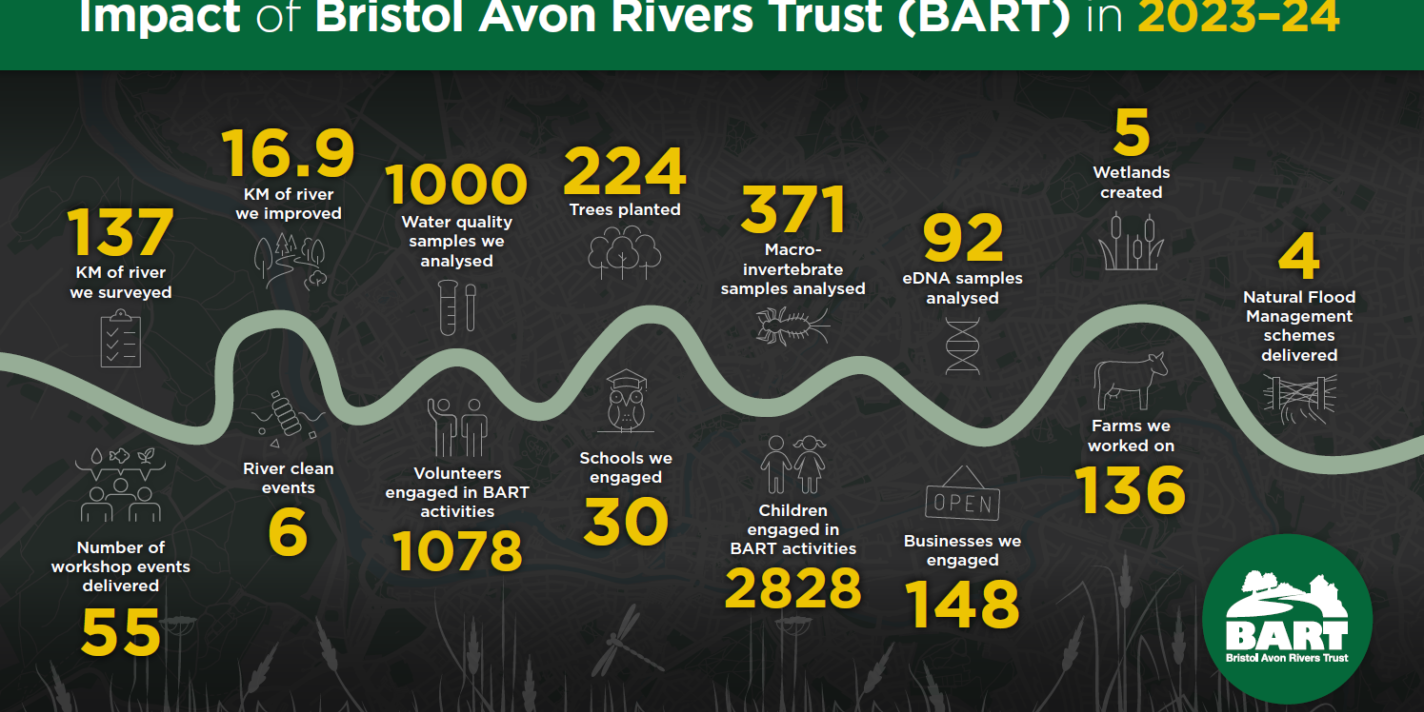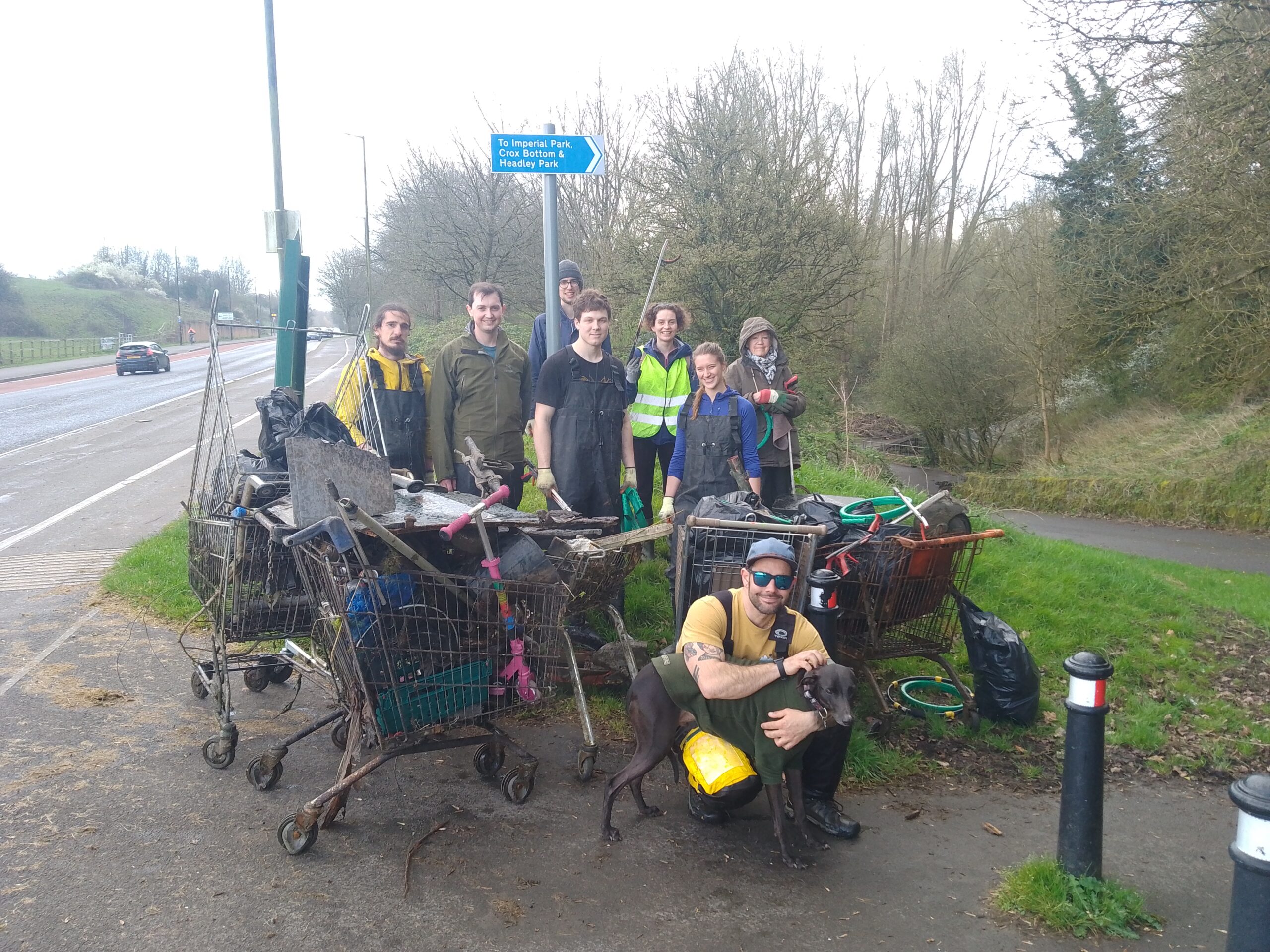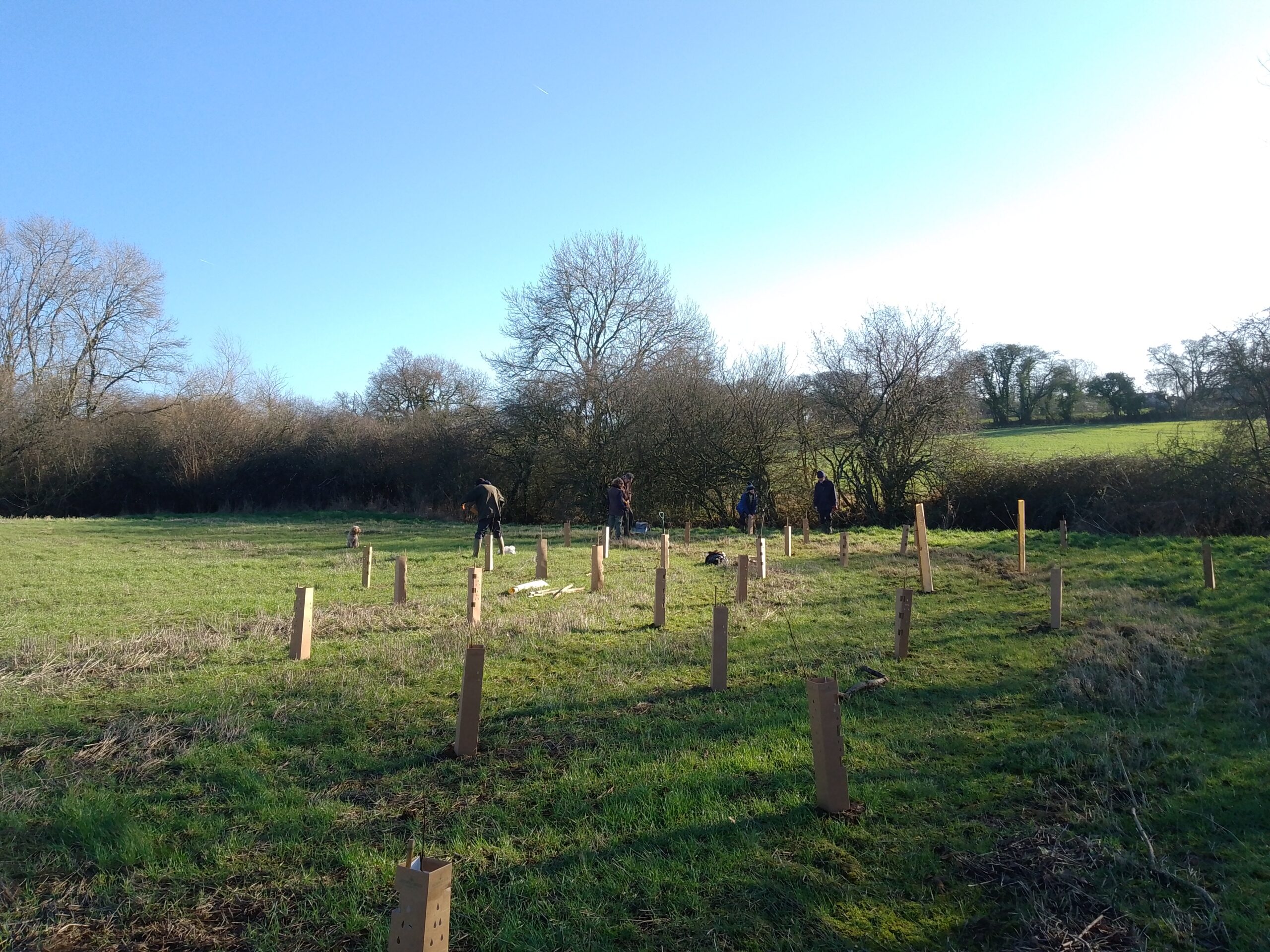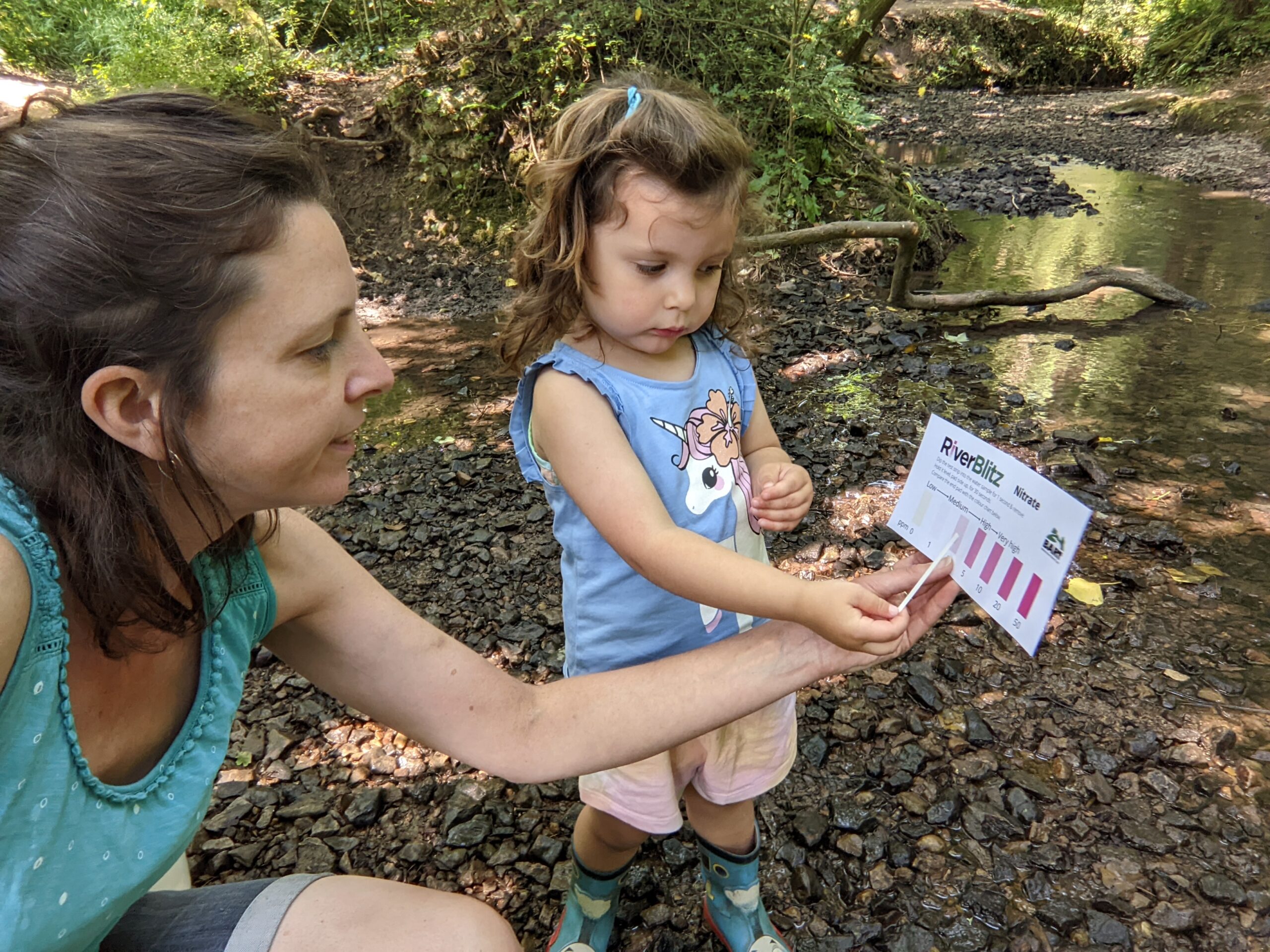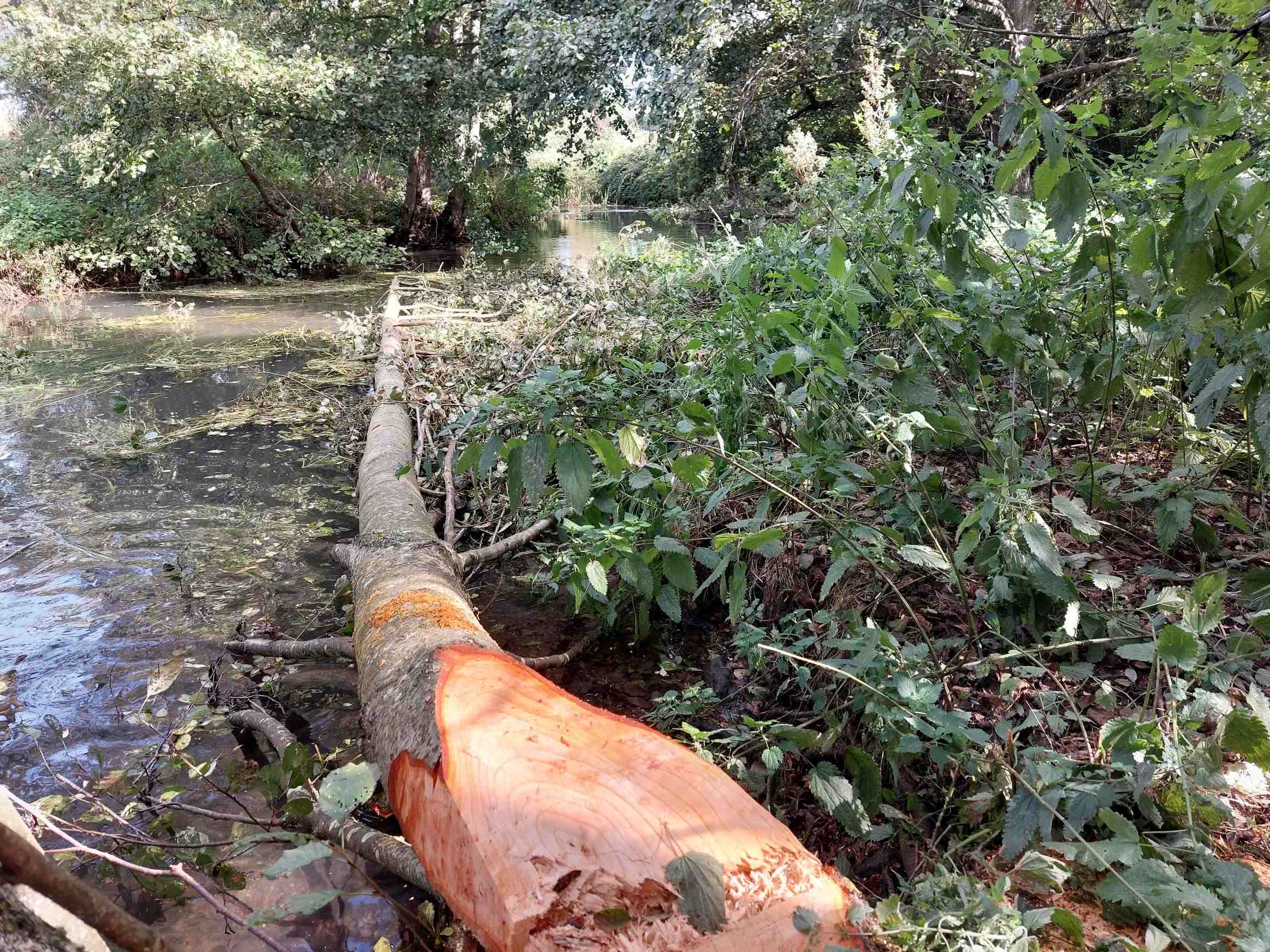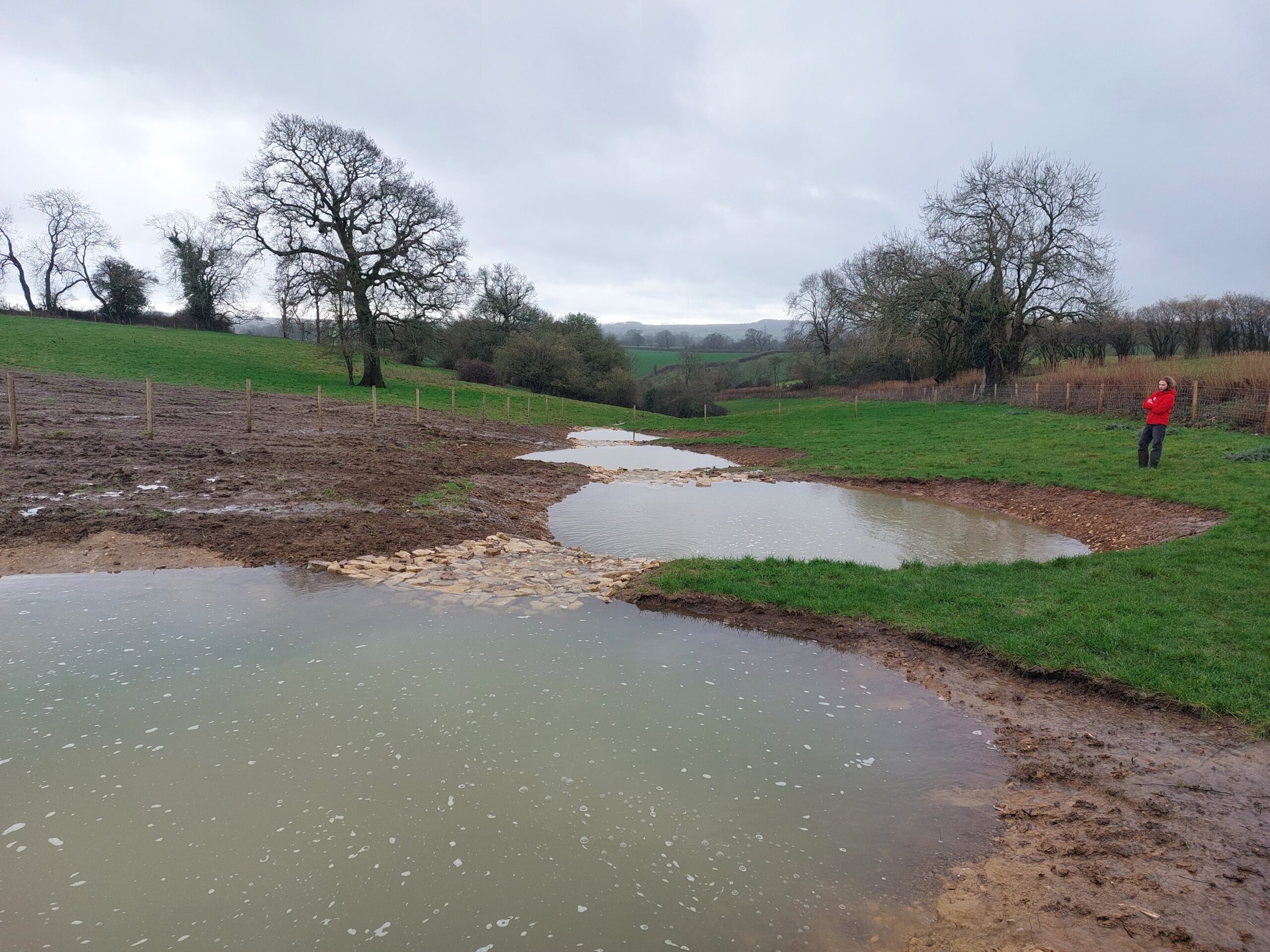Indicators of Our Success: Beyond the Numbers
As a science-based organisation, we love and value statistics. See our infographic for a snippet of our 2023 achievements in numbers. While statistics provide a glimpse into the successful outcomes of our work, the true measure of our impact lies in the intangibles—the camaraderie among our volunteers, the strong connections with farming and angling communities, and the partnerships with grassroots and governmental environmental organisations. Our team spirit is evident among our employees, and most importantly, our positive influence is reflected in the revitalised river habitats we restore and protect, which thrive and teem with life.
Across the diverse catchments of Bristol, South Gloucestershire, Bath & North East Somerset, Wiltshire, and North Somerset, our efforts are sustained by the collective contributions of individuals and groups. These ongoing endeavours breathe life into the region’s rivers. Thank you for being a part of this journey.

A Message from Our CEO, Simon Hunter
“In our region, our work has continued at volume and at pace.”
“In 2023, we undertook a variety of projects to benefit our rivers. Highlights include the Bristol Avon Fish Recovery Strategy and the Action Plan for the River Chew, which have significantly raised awareness of our local ‘blue spaces.’ These initiatives have developed holistic plans to facilitate the migration of fish to high-quality spawning habitats, which the Trust is now actively implementing. Additionally, our citizen science efforts expanded, attracting new volunteers and becoming part of a regional citizen science pilot, in collaboration with stakeholders across the Bristol Avon catchment.”
“The dedication and relentless energy of our teams, both in the field and in core support roles, have enabled our charity to thrive despite the challenges of securing funding for BART’s growing team. We deeply appreciate their passion for delivering results for our region’s rivers. We are equally grateful for the contributions of our trustees, volunteers, partners, collaborators, and donors, who all play a crucial role in keeping our freshwater environments vibrant and healthy.”
“With so many new schemes coming on board in our 12th year, we still have much to do for our rivers while reflecting on the successes of 2023.”
Our Projects
To ensure the vitality of our region’s freshwater environments, our teams are dedicated to a range of areas, including community and volunteer engagement, land and river management, river monitoring, mapping, communications, fundraising, finance, HR, IT, and beyond.
Our staff is deeply committed to enhancing riverine and estuarine ecosystems, which ultimately support the health of marine environments. Below, we highlight some of the remarkable achievements from 2023 that have strengthened the health of our rivers, streams, and watercourses.
Read on to learn more about our charity’s positive impact on the region’s rivers:
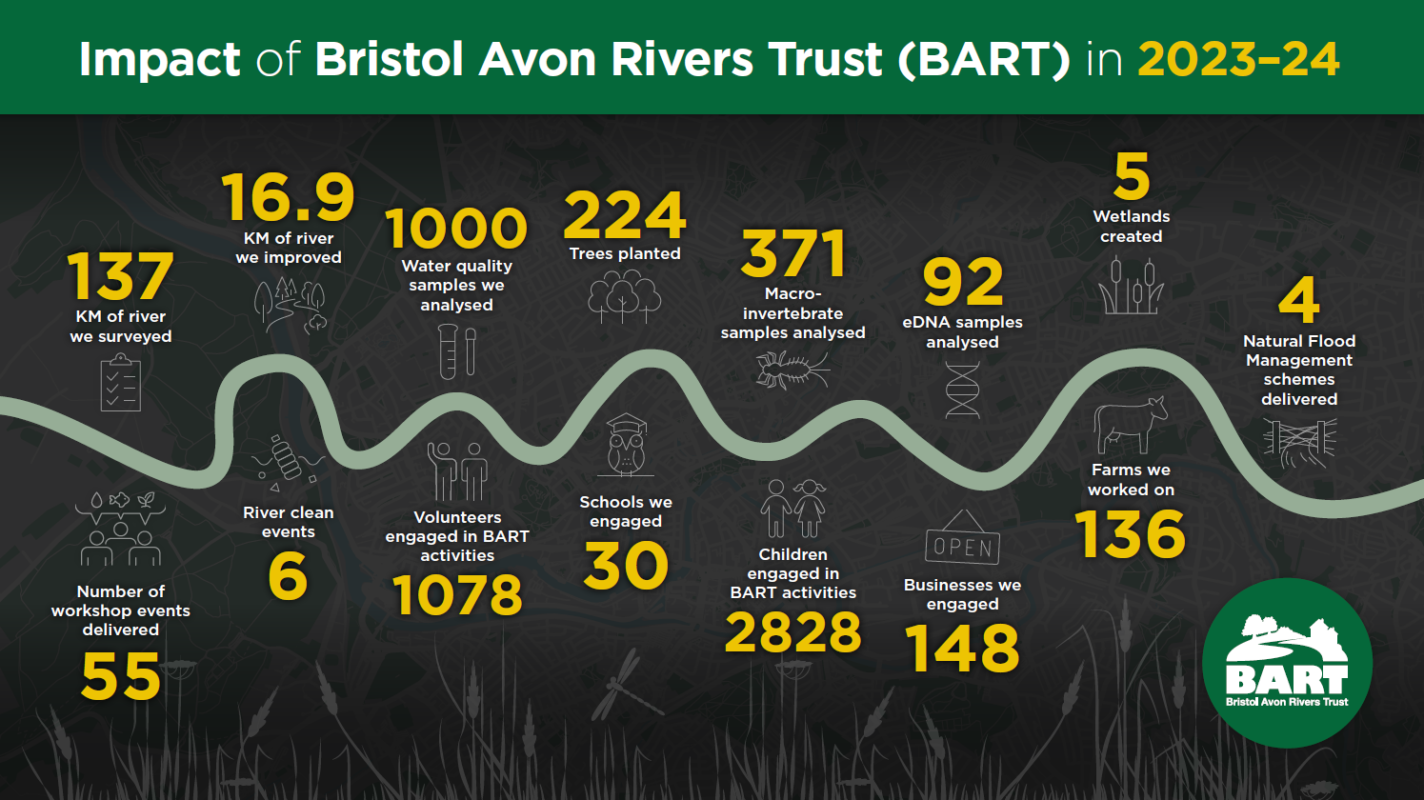
Completion of the Bristol Avon Fish Recovery Strategy
During 2023, we were pleased to announce the completion of the Bristol Avon Fish Recovery Strategy, a comprehensive plan designed to address the challenges facing fish populations in the catchment and to identify opportunities for their recovery. A copy of the strategy can be found via the Bristol Avon Catchment Partnership’s website: https://www.bristolavoncatchment.co.uk/bristol-avon-fish-recovery-strategy/
The project was funded by the Bristol Avon Catchment Partnership project grant scheme.
Key Components of the Strategy:
- Challenges and Opportunities: The strategy outlines the primary challenges that fish populations in the Bristol Avon face, such as habitat degradation, barriers to migration, and pollution. It also identifies areas where interventions can most effectively support fish population recovery.
- Guiding Principles and Multi-Sector Approach: A core component of the strategy is its emphasis on guiding principles for fish recovery, underscoring the necessity of a collaborative, multi-sector approach. This approach brings together stakeholders from various sectors, including agriculture, conservation, and urban planning, to work towards common goals.
- Action Plan: Included within the strategy is a detailed action plan that outlines high-level actions needed to facilitate fish recovery across the catchment. The plan also sets up mechanisms for monitoring progress to ensure the strategy’s goals are being met.
Strategic Integration:
The Bristol Avon Fish Recovery Strategy operates at a strategic level within the catchment and the broader region. It is integrated into several regional and environmental frameworks, ensuring its principles and actions align with wider conservation efforts. Specifically, it is considered in the development and implementation of:
- The Local Nature Recovery Strategy for the region.
- Biodiversity Net Gain initiatives.
- Environmental Land Management Schemes.
Additionally, the strategy is featured on the West of England Combined Authority website as a key regional document, reflecting its importance in the region’s environmental planning.
Alignment with Regional Strategies:
The Bristol Avon Fish Recovery Strategy complements a suite of regional and environmental strategies, including:
- The West of England Climate and Ecological Strategy and Action Plan: A plan to address climate change and ecological challenges in the region.
- The West of England Nature Recovery Strategy: Focuses on restoring and enhancing natural habitats and biodiversity.
- The Forest of Avon Plan: Aims to increase tree coverage and enhance green spaces in the area.
- The Joint Green Infrastructure Strategy: Integrates green infrastructure planning to support sustainable urban and rural development.
By aligning with these strategies, the Bristol Avon Fish Recovery Strategy plays a crucial role in promoting a resilient and biodiverse future for the region’s rivers and aquatic ecosystems.
Completion of the River Chew Fish Recovery Action Plan
We are delighted to announce the completion of the River Chew Fish Recovery Action Plan. This comprehensive plan outlines prioritised measures to enhance freshwater biodiversity and specifically support the recruitment of wild fish populations throughout the River Chew.
The project was funded by the Bristol Avon Catchment Partnership project grant scheme.
Key Elements of the Plan:
- Prioritised Actions: The plan provides a detailed list of priority measures aimed at improving freshwater ecosystems and boosting wild fish recruitment in the Chew. These actions are designed to address the specific needs and challenges of the river’s fish populations.
- Detailed Project Information: An internal Excel file has been developed for use by partners, containing in-depth information on proposed projects. This resource offers detailed insights into each project’s scope and objectives.
- Public-Facing StoryMap: To effectively communicate the plan’s initiatives to a broader audience, we have created an ArcGIS StoryMap. This interactive tool showcases the necessary work in the Chew, including case studies and images that illustrate what successful project implementation might look like.https://storymaps.arcgis.com/stories/c3a18567c45a46e787d6f6e5f77bd6e7
- Ecosystem Benefits and Project Synergies: Beyond fish recovery, the plan highlights additional ecosystem benefits that can be achieved through these projects, such as enhanced water quality and habitat diversity. It also provides details on indicative project costs, the extent of river habitat that could be opened up, and potential synergies with other ongoing projects in the area.
Future Blueprint for the Bristol Avon:
The River Chew Fish Recovery Action Plan is set to become a model for developing similar plans in other sub-catchments within the Bristol Avon region. This blueprint will guide efforts to create tailored fish recovery strategies that address the unique needs of each sub-catchment.
Adoption and Monitoring:
The plan has been formally adopted by the Chew Valley Reconnected partnership. Moving forward, the partnership will monitor progress against the plan to ensure its goals are being met and to adapt strategies as needed.
By providing a clear roadmap for fish recovery and broader ecosystem improvements, the River Chew Fish Recovery Action Plan is a significant step towards a healthier and more resilient river ecosystem in the Bristol Avon region.
South Bristol Communities Reconnected Project
In March 2023, the Bristol Avon Rivers Trust (BART) published an opportunities report for the South Bristol rivers and streams, pinpointing a range of river and habitat restoration possibilities across the Malago, Pigeonhouse, and Colliters Brook catchments. This project is actively implementing community-level recommendations from the report, focusing on enhancing the wellbeing and connections of residents to blue-green spaces in South Bristol.
The project was funded by the Bristol Avon Catchment Partnership project grant scheme.
Key initiatives include:
- Community Outreach: We are delivering a comprehensive community outreach program aimed at increasing people’s wellbeing and fostering a deeper connection to their local rivers and green spaces.
- Volunteer Education and Training: We are educating and upskilling local volunteers by organizing one complex woody debris project and hosting two habitat enhancement days.
- River Enhancement: A ~100m section of the Malago in Bedminster is being improved for both wildlife and community enjoyment through the installation of complex woody debris.
- Riverfly Monitoring Network: We are establishing a riverfly monitoring network across the catchments to track and understand ecological changes over time.
These efforts are designed to not only restore and enhance local waterways but also to engage and empower the South Bristol community, fostering a stronger bond between people and their natural environment.
Gauze Brook Restoration Project in Hullavington, Wiltshire
Building on the previous efforts of the Bristol Avon Rivers Trust (BART) in collaboration with the Hullavington Environmental Group, we are excited to deliver the next phase of our project to restore 0.5 km of the Gauze Brook. This phase focuses on the section between Surrendell Cottage and Windmill Hill Brake in Hullavington.
The project is funded by the Bristol Avon Catchment Partnership, project grant scheme.
The project encompasses several key activities designed to enhance the health and biodiversity of this stretch of the Gauze Brook:
- Coppicing and Riparian Tree Planting: We have strategically coppiced and planted trees along the 0.5 km reach to optimize the balance of light and shade. This careful management encourages the growth of macrophytes (aquatic plants) and supports the establishment of fish populations. Over time, these trees will also help stabilize the banks and reduce erosion as their roots develop, addressing a significant local issue.
- Utilising Coppiced Wood for Habitat Creation: The wood from the coppiced trees is being repurposed to create brushwood berms at carefully chosen locations along the brook. These berms will narrow the channel, enhancing flow diversity in areas previously widened by historic land management and milling activities.
- Creating Scour and Gravel Habitats: The strategic placement of these brushwood berms will create areas of scour, exposing clean gravel beds. These habitats are ideal for fish spawning and provide a rich environment for invertebrates to thrive.
Through these measures, we aim to rejuvenate the Gauze Brook’s ecosystem, fostering a more vibrant and sustainable environment for both aquatic life and the surrounding community. This project is a testament to our commitment to restoring natural watercourses and enhancing their ecological value.
RiverBlitz: Empowering Communities to Explore and Protect Local Waterways
RiverBlitz is an annual citizen science initiative organized by the Bristol Avon Rivers Trust (BART) that captures a snapshot of water quality and ecological health in rivers and streams across the catchment. Using affordable test strips, participants of all ages and backgrounds are empowered to connect with their local watercourses and take an active role in safeguarding their natural environment.
The project was funded by a multitude of organisations whom we are very grateful for their support: Wiltshire Wildlife Trust, Avon Wildlife Trust, Osborne Clarke Charitable Fund, Robert Clutterbuck Charitable Trust, Triodos Foundation, Big Give, Bristol Water, Bristol Avon Catchment Partnership, Natural History Consortium and Allford Hall Monaghan Morris.
Key Highlights of RiverBlitz:
- Inclusive Participation: RiverBlitz encourages community involvement by making it easy for everyone to participate, regardless of age or background. This initiative fosters a sense of connection to local rivers and streams and raises awareness about the importance of protecting these vital ecosystems.
- Data Collection and Analysis: By collecting data during RiverBlitz events, BART has been able to pinpoint areas with both good and poor water quality. This information helps to identify pollution sources and prioritize areas for further investigation and monitoring.
- Historical and Comparative Insights: BART’s data platform, associated with RiverBlitz, enables comparisons across different years (dating back to 2016) and locations. This feature provides a comprehensive view of water quality trends over time and across various parts of the catchment.
- Targeted Monitoring: Insights from RiverBlitz inform targeted, more detailed, and frequent monitoring through other citizen science programs. This strategic approach enhances the effectiveness of BART’s efforts to improve water quality in the catchment.
Innovative Data Sharing:
Building on the success of the RiverBlitz data platform, BART has expanded this model into the RiverHub. This advanced platform integrates citizen science data with information from water companies, offering a richer context for understanding water quality issues. The RiverHub serves as a valuable resource for stakeholders and the community, providing a clearer picture of water quality across the catchment.
Through initiatives like RiverBlitz, BART continues to engage and empower communities, fostering a collaborative effort to monitor and enhance the health of local water ecosystems.
Enhancing the Sherston Avon with Woody Structures
In the autumn of 2023, the Bristol Avon Rivers Trust (BART) embarked on a significant river restoration project along a 150-meter stretch of the Sherston Avon near Easton Grey, Wiltshire. Funded by the Environment Agency Fisheries Improvement Programme, The Halpin Trust, and the Easton Grey Fishing Syndicate, this initiative involved the construction of nine complex woody material structures designed to enhance the river’s ecological health.
The project was conceived after a detailed river walkover with members of the Easton Grey Fishing Syndicate in 2022. The goal was to devise sustainable management and restoration strategies to support the wild fish populations in the Sherston Avon. Currently, this section of the river is rated poorly under the Water Framework Directive, primarily due to groundwater extraction. These conditions have been exacerbated by climate change, leading to lower water levels, reduced river flows, and subsequent drops in dissolved oxygen levels, all of which pose significant stress to aquatic wildlife.
Initial surveys and walkovers revealed that this segment of the river, historically altered, had become overwide and too shallow, especially during dry weather. This underscored the need for the addition of complex woody structures to narrow the channel, enhance flow diversity, and create deeper habitats that would benefit the river’s ecosystem.
These improvements are expected to bolster the resilience of the Sherston Avon, helping it recover and thrive despite ongoing environmental challenges.
By strategically placing woody structures in the river channel, we can effectively “pinch” the flow at selected points, promoting natural river processes, creating varied in-stream habitats, and offering refuge areas for juvenile fish. These efforts are crucial for enhancing the river’s resilience to climate change. The increased flow around these structures encourages natural patterns of scour and deposition, helping to expose and clean gravels. This process is vital for providing habitats for invertebrates, river plants, and spawning fish like brown trout.
Over three days, BART staff, alongside dedicated volunteers from the Easton Grey Fishing Syndicate and a team from Mott McDonald, constructed these woody structures. Working with a contractor, they selectively harvested woody material from the site. The team then packed woody brash behind large woody deflectors—essentially tree trunks positioned adjacent to the riverbank—forming wedge-shaped designs. These were securely anchored with aged chestnut stakes. During high-flow events, water will overtop these structures, depositing suspended sediment as it slows down through the structure. Over time, this sediment deposition will support the growth of bankside vegetation within the structures, effectively extending the riverbank and creating new, crucial marginal habitats.
Additionally, the project included creating several hinged trees. This involves a contractor partially cutting a bankside tree trunk, then carefully felling it into the river while keeping it attached to the stump. The tree remains alive and rooted, preventing it from being washed away during high flows. These hinged trees restore complexity to river habitats, mimicking natural occurrences of bankside trees falling into the water.
This thoughtful approach not only helps restore the ecological health of the Sherston Avon but also strengthens its ability to adapt and thrive in the face of environmental changes.
Little Blew Natural Flood Management Project
Throughout the Autumn and Winter of 2023, BART secured funding from the Environment Agency and a local landowner to design and implement a Natural Flood Management project at Little Blew, in the headwaters of the Cam Brook, Bath & Northeast Somerset. This site features an ephemeral stream (a stream which only flows after heavy rainfall) flowing through a valley of pasture lands. The project’s objective is to ‘slow the flow’ by retaining water in a series of wetlands and using woody debris to divert the stream across the valley. This approach creates a mosaic of habitats while reducing downstream flooding. Collaborating closely with the landowner, the project was tailored to support ongoing livestock grazing while enhancing local biodiversity and flood resilience.
What is Natural Flood Management?
Natural flood management (NFM) encompasses various nature-based solutions to mitigate flooding risks while simultaneously benefiting ecosystems. Implemented at a catchment scale, NFM involves diverse methods across headwaters to retain water and reduce peak river levels during heavy rainfall events. Techniques include improving field buffer strips, tree planting, constructing leaky dams, and enhancing soil health. These actions collectively slow the water’s journey to the main river channel, effectively lowering peak flow levels.
Project Implementation at Little Blew :
Creating Wetland Depressions
Following feasibility assessments, contractors were engaged to excavate four wetland depressions at strategic locations at the field’s head. These seasonal wetlands remain dry until the stream flows during high rainfall periods, covering approximately 600m² and significantly storing water. Recent heavy rains demonstrated their effectiveness as they quickly filled, preventing a large volume of water from rapidly reaching the River Cam. To combat headward erosion at the flow pathways between the wetlands, stone from the excavations was used to build a stone ‘shelf’ over the outflow pathways, ensuring long-term water retention capacity. Over time, vegetation will colonize these depressions, blending them with the landscape and allowing continued livestock grazing during dry conditions.
Utilising Woody Debris
Further downstream, we strategically placed complex woody debris, selectively collected from the on-site woodland, along the flow pathway to maximize impact. These structures help spread the flow across the field, forming mini temporary wetlands that slow water movement and capture sediment, which could otherwise harm river health. These wetter areas diversify the grassland habitats, creating niches for various plant species to establish.
Enhancing Soil Infiltration and Habitat Diversity
By dispersing the flow pathways, we extend the water’s journey to the main channel, increasing soil infiltration opportunities and promoting longer-term water storage. This also fosters the development of wet meadow habitats, attracting species that thrive in wetter conditions. At the valley’s lower end, we dug two scrapes to channel surface water back into the main stream while ensuring that the existing livestock feeding area remains dry. This design prevents mud accumulation around the feeding station from being washed into the river.
Transformative Outcomes
The images showcase the transformation from a simple, single-channelled ephemeral stream into a complex network of interlacing channels and wetlands. This diversity will provide enhanced ecosystem services, such as improved flood mitigation and richer habitats. It’s rewarding to see these interventions functioning as intended so soon after implementation, and we look forward to observing their continued development and positive impact on local habitats and downstream flood risks.
This project exemplifies how thoughtful natural flood management can simultaneously support agricultural practices, enrich local biodiversity, and mitigate flood risks, illustrating the multifaceted benefits of such interventions.

